The History and Evolution of Telescopes: From Galileo to Modern Times
Telescope prices have changed dramatically since the invention of the first telescope, reflecting advancements in technology and accessibility. The evolution of telescopes has been a journey of innovation, from the rudimentary designs of the 17th century to the sophisticated instruments used today.
1. The Early Beginnings
Galileo and the First Telescope
The story of the telescope begins in the early 1600s with the Dutch spectacle maker Hans Lippershey, who is credited with creating the first refracting telescope. However, it was Galileo Galilei who improved upon this design in 1609, using it to observe celestial bodies. Galileo’s telescope had a modest magnification of about 20x, yet it revolutionized our understanding of the cosmos. With it, he discovered the moons of Jupiter, the phases of Venus, and the rugged surface of the moon.
2. The Reflecting Telescope
Newton’s Contribution
In 1668, Isaac Newton developed the first reflecting telescope, which used a curved mirror instead of lenses to gather light. This design eliminated chromatic aberration—a problem in refracting telescopes where colors would blur together. Newton’s reflector provided clearer images and paved the way for larger telescopes.
3. Modern Telescopes
Advancements in Technology
Over the centuries, telescopes continued to evolve. The 20th century saw the introduction of the Hubble Space Telescope, which orbits Earth and provides stunning images of the universe without atmospheric distortion. Today, modern telescopes, both ground-based and space-based, utilize advanced optics, digital imaging, and computer technology to explore the universe with unprecedented clarity.
4. The Impact on Astronomy
The evolution of telescopes has profoundly impacted our understanding of the universe. From Galileo’s simple refractor to the complex instruments of today, telescopes have opened new windows into space, allowing astronomers to study distant galaxies, exoplanets, and the fundamental nature of the cosmos.
The history of the telescope is a testament to human curiosity and ingenuity, continually pushing the boundaries of what we can observe and discover in the universe.

